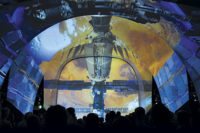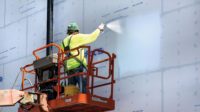Located in downtown Miami’s Museum Park, the Phillip and Patricia Frost Museum of Science Aquarium façade presented obstacles beyond site logistics. “The combination of four realities challenged the team: a patterned compound curving façade, tight tolerance, unique structural attachment and Miami-Dade NOA,” said Paul Wolmarans, CEO-Kenpat. “Assembling a core team to bring the right expertise at the right time is the key to the success of this project. To kick-off the effort, we agreed to start with an intensive three-day collaboration.”
Patterned Compound Curving Façade
The façade team delivered a custom curved structural light-gauge framing system that displaced an earlier proposal for laser cut red iron steel plates. The change decreased overall steel costs and provided greater control of the finished surface geometry. A two-way framing system achieved geometric control in both the vertical and horizontal directions. Vertically oriented custom curved, cold-formed steel structural stud framing attached to the as-built concrete superstructure. The stud layer transferred loads from fiberglass faced gypsum wallboard, waterproofing and a lattice of cold formed steel hat-channel. The lattice provided adjustability to deliver a smooth fastening surface for the stucco and tile façade. This double layer light-gauge system provided separation of the moisture barrier from the finish surface assembly to minimize membrane penetrations. The hat-channel lattice formed a vented cavity to promote air movement through the system to help evacuate errant moisture.
“Our team developed a process that enabled us to take two-dimensional details, deploy them three dimensionally and create a feedback loop to gain exposure on the project all the way around,” said Jeff Montague, Radius Track Corporation Sr. Design Technologist. “During structural stud installation X, Y and Z coordinates from the 3-D model informed total station site survey equipment to precisely locate each light gauge framing element that Radius Track fabricated.
Project Notes
The Aquarium façade team of experts included:
- Exterior Wall System Contractor: Kenpat USA
- Cold-formed Steel Parametric Design, Fabrication, Coordination: Radius Track Corp.
- Cold-formed Steel Design & Engineering: McClure Engineering Co.
- Skin Parametric Modeling & Design Coordination: Kotronis Consulting LLC
- Light Gauge Connectors: The Steel Network
Key Project Team members working closely with the façade team:
- Project Owner/Developer: Phillip and Patricia Frost Museum of Science
- Design Architect: Grimshaw Architects
- Architect of Record: Rodriquez and Quiroga Architects Chartered
- Structural Engineer: DDA Engineers, P.A.
- Construction Management/GC: Skanska
- Project Management: Hill International
- Building Enclosure Consultant: Heitmann & Associates Inc.
On the stucco and tile façade surface, each linear parallelogram contained circular tiles arranged in a fixed linear array with close spacing. The 3-inch tiles used are the largest possible tile that can be pre-mounted onto sheets, in this case, sheets of 12 tiles. The tile joint pattern was chosen carefully by the architect to avoid creating a distorted grid. Instead, the panels run continuously in one direction and are offset in the other direction to form their trapezoidal shape. Arranging the joints in this manner creates a more dynamic appearance across the façade as the tiles appear to wrap the form continuously from top to bottom. The joints were laid out perfectly to not require the cutting of any tiles. With great accuracy, the tiles were applied to the façade without issue, achieving the desired effect.
Tight Tolerance
The specified 3/16 inch linear parallelogram pattern tolerance required investigation of the finished surface in real time using parametric modeling to elucidate impacts of framing connections to the concrete superstructure. “We have borrowed tools from the aerospace industry. Those tools allow us to not only model the geometry but also the complex sets of relationships between building systems: how does the skin relate to the concrete, how does the pattern relate to the skin and how do the tiles relate to that pattern,” said James Kotronis, Kotronis Consulting LLC. Through this process, the team identified clashes and possible engineering problems. They then studied and redesigned each to maintain the appropriate depth needed for the assembly build up and to ensure that the 3/16 inch linear pattern tolerance was maintained.
Unique Structural Attachment & Miami-Dade NOA
Structurally, the façade assembly hangs like a curtain from the aquarium’s fourth-floor slab. Studs stand off from the slab at grade where metal clips stay their location.
“Engineering design for this project goes beyond the industry standard,” said MEC’s Patrick Earney, PE, SE. “The cladding system was uniquely designed for drift, which allows the structure to move independently without causing failure of the cladding system. In addition, light gauge connectors were custom designed to support the large load individually and make installation efficient and easy.”
The entire façade system is designed for wind speeds up to 120 PSF, engineered to withstand L/720 loads, high impact projectiles and received Miami-Dade NOA. It embodies the best of what the team delivered using advanced engineering, virtual modeling, precision fabrication and construction services in realizing the architect’s vision.
Construction quality and craftsmanship for this project grew from collaborative design and coordinated teamwork—including engineering, fabrication, installation, attention to detail and digital to physical feedback loops. Information gained during virtual design ported seamlessly to precision engineering, fabrication, set out and installation.
From the kick-off through façade completion, the team maintained open communication; persistence to explore each iteration necessitated by as-built conditions and espoused the philosophy of partnering with the owner and design team to achieve a common goal. Delivering a project as complicated as the aquarium building is only possible by collaborative effort. This team was put together because they are the experts in their field and were focused on what needed to be done to create a project that is the best for the owner and the building, and I believe that is the future of architecture.







Report Abusive Comment